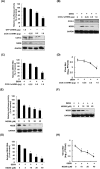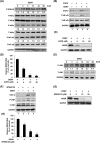Cyclooxygenase-2 facilitates dengue virus replication and serves as a potential target for developing antiviral agents
- PMID: 28317866
- PMCID: PMC5357798
- DOI: 10.1038/srep44701
Cyclooxygenase-2 facilitates dengue virus replication and serves as a potential target for developing antiviral agents
Abstract
Cyclooxygenase-2 (COX-2) is one of the important mediators of inflammation in response to viral infection, and it contributes to viral replication, for example, cytomegalovirus or hepatitis C virus replication. The role of COX-2 in dengue virus (DENV) replication remains unclear. In the present study, we observed an increased level of COX-2 in patients with dengue fever compared with healthy donors. Consistent with the clinical data, an elevated level of COX-2 expression was also observed in DENV-infected ICR suckling mice. Using cell-based experiments, we revealed that DENV-2 infection significantly induced COX-2 expression and prostaglandin E2 (PGE2) production in human hepatoma Huh-7 cells. The exogenous expression of COX-2 or PGE2 treatment dose-dependently enhanced DENV-2 replication. In contrast, COX-2 gene silencing and catalytic inhibition sufficiently suppressed DENV-2 replication. In an ICR suckling mouse model, we identified that the COX-2 inhibitor NS398 protected mice from succumbing to life-threatening DENV-2 infection. By using COX-2 promoter-based analysis and specific inhibitors against signaling molecules, we identified that NF-κB and MAPK/JNK are critical factors for DENV-2-induced COX-2 expression and viral replication. Altogether, our results reveal that COX-2 is an important factor for DENV replication and can serve as a potential target for developing therapeutic agents against DENV infection.
Conflict of interest statement
The authors declare no competing financial interests.
Figures








Similar articles
-
Lucidone suppresses dengue viral replication through the induction of heme oxygenase-1.Virulence. 2018 Jan 1;9(1):588-603. doi: 10.1080/21505594.2017.1421893. Virulence. 2018. PMID: 29338543 Free PMC article.
-
Celastrol inhibits dengue virus replication via up-regulating type I interferon and downstream interferon-stimulated responses.Antiviral Res. 2017 Jan;137:49-57. doi: 10.1016/j.antiviral.2016.11.010. Epub 2016 Nov 12. Antiviral Res. 2017. PMID: 27847245 Free PMC article.
-
AR-12 suppresses dengue virus replication by down-regulation of PI3K/AKT and GRP78.Antiviral Res. 2017 Jun;142:158-168. doi: 10.1016/j.antiviral.2017.02.015. Epub 2017 Feb 24. Antiviral Res. 2017. PMID: 28238876
-
Preclinical Antiviral Testing for Dengue Virus Infection in Mouse Models and Its Association with Clinical Studies.ACS Infect Dis. 2018 Jul 13;4(7):1048-1057. doi: 10.1021/acsinfecdis.8b00054. Epub 2018 Jun 1. ACS Infect Dis. 2018. PMID: 29756760 Review.
-
The search for nucleoside/nucleotide analog inhibitors of dengue virus.Antiviral Res. 2015 Oct;122:12-9. doi: 10.1016/j.antiviral.2015.07.010. Epub 2015 Aug 1. Antiviral Res. 2015. PMID: 26241002 Review.
Cited by
-
Antiviral Efficacy of the Anesthetic Propofol against Dengue Virus Infection and Cellular Inflammation.J Immunol Res. 2021 Mar 31;2021:6680913. doi: 10.1155/2021/6680913. eCollection 2021. J Immunol Res. 2021. PMID: 33869639 Free PMC article.
-
American-Asian- and African lineages of Zika virus induce differential pro-inflammatory and Interleukin 27-dependent antiviral responses in human monocytes.Virus Res. 2023 Feb;325:199040. doi: 10.1016/j.virusres.2023.199040. Epub 2023 Jan 5. Virus Res. 2023. PMID: 36610657 Free PMC article.
-
Cellular Stress Responses against Coronavirus Infection: A Means of the Innate Antiviral Defense.J Microbiol Biotechnol. 2024 Jan 28;34(1):1-9. doi: 10.4014/jmb.2307.07038. Epub 2023 Sep 8. J Microbiol Biotechnol. 2024. PMID: 37674398 Free PMC article. Review.
-
Exploiting host kinases to combat dengue virus infection and disease.Antiviral Res. 2025 Sep;241:106172. doi: 10.1016/j.antiviral.2025.106172. Epub 2025 May 8. Antiviral Res. 2025. PMID: 40348023 Review.
-
Dengue Virus Induced COX-2 Signaling Is Regulated Through Nutrient Sensor GCN2.Front Immunol. 2020 Aug 13;11:1831. doi: 10.3389/fimmu.2020.01831. eCollection 2020. Front Immunol. 2020. PMID: 32903536 Free PMC article.
References
Publication types
MeSH terms
Substances
LinkOut - more resources
Full Text Sources
Other Literature Sources
Research Materials

